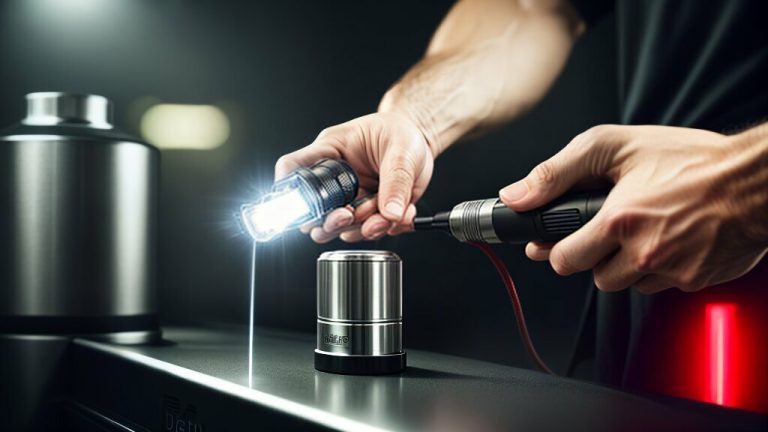Are you tired of struggling with a poorly functioning torch lighter? The problem could be as simple as improper refilling. Refilling your torch lighter properly can save you time, money, and frustration.
This easy step-by-step guide takes you through safely and effectively refilling your torch lighter. Whether you’re a cigar aficionado or need a reliable tool for DIY projects, understanding the best ways to refill a torch and clipper lighter is essential.
Key Takeaways:
- Properly refilling your torch lighter can improve its functionality and longevity.
- Using high-quality fuel is crucial for optimal performance.
- Following manufacturer instructions is essential to ensure safe and effective refilling.
Understanding Your Torch Lighter
Before you begin refilling your torch lighter, it’s essential to understand your lighter type and the appropriate refilling method. Various types of torch lighters are available, including single-flame, double-flame, and triple-flame torches. Each type may require a different kind of fuel or refilling technique.
Some torch lighters have visible fuel gauges, while others require you to estimate the fuel level. The material and construction of the lighter can also affect the refilling process. For example, lighters made of plastic or other delicate materials may require more careful handling during refilling to avoid damage.
Understanding Refilling Methods and Tips
Depending on the model and manufacturer’s instructions, there are various ways to refill a torch lighter. Some lighters are designed for filling using a fuel canister, while others require a screwdriver to access the refill valve.
Regardless of the refilling method, it’s essential to be aware of basic safety precautions, such as keeping the lighter away from open flames and avoiding overfilling. Additionally, using high-quality fuel can improve the performance and lifespan of your torch lighter.
By familiarizing yourself with the type of torch lighter you have and the appropriate refilling method, you can ensure a safe and successful refill.
Gathering the Necessary Supplies
Before refilling your torch lighter, it is essential to gather the necessary supplies. Here’s what you’ll need:
| Supply | Description |
|---|---|
| Torch lighter fuel | It is recommended to use high-quality butane torch fuel for optimal performance and to avoid clogging the lighter’s valves. |
| Small screwdriver | Some lighters may require a small screwdriver to release residual pressure before refilling. |
| Paper towel | Use a paper wipe away any overflowing fuel spilled during refilling. |
Read the manufacturer’s instructions and recommendations for refilling your torch lighter model. Some lighters may require additional tools or accessories for safe and proper refilling.
Remember that safety is always a top priority. Use caution when handling the fuel and avoid smoking or igniting any flames during refilling.
Preparing Your Torch Lighter for Refilling
Before refilling your torch lighter, preparing it for safe and efficient filling is essential. Follow these steps to ensure your torch lighter is ready:
| Step | Description |
|---|---|
| Step 1: | Turn off the lighter and extinguish any remaining flame by pressing the ignition button until the flame is no longer visible. |
| Step 2: | If your lighter has a fuel adjustment valve, turn it to the lowest setting. |
| Step 3: | Release any residual pressure left in the lighter by depressing the refill valve with a small tool such as a pen or screwdriver. When releasing the tension, you point the lighter away from your face and body. |
| Step 4: | Place the lighter on a flat, stable surface to prevent any fuel spillage during the refilling process. |
It is crucial to follow these steps cautiously to prevent potential accidents and ensure the proper functioning of the lighter during use. Always refer to the manufacturer’s instructions for specific guidelines on preparing your torch lighter for refilling.
Refilling Your Torch Lighter
Once you have gathered all the necessary supplies and prepared your torch lighter for refilling, it’s time to begin the actual process of refilling. Follow these easy steps:
- Locate the refill valve on your torch lighter. This is usually located on the bottom of the lighter and can be identified by a small hole.
- Insert the nozzle into the refill valve. Make sure it fits securely, and there are no leaks.
- Press down on the fuel canister to start refilling. Maintain steady and even pressure while filling.
- Check the fuel level visually. You can do this by looking through the transparent portion of the lighter or by using a flashlight. Stop refilling once you reach the appropriate fuel level.
- Remove the fuel canister from the refill valve. Wipe away any excess fuel that may have spilled.
It is important to note that different torch lighters may have variations in their refill process. Incorporate these manufacturer’s instructions for your specific model to ensure optimal performance.
Checking for Proper Fuel Fill
After filling your torch lighter with fuel, checking for a proper fill is important to ensure optimal performance. Hold the lighter away from your face to check the fuel level and tilt it slightly to one side. You should be able to see the fuel level through the transparent fuel tank or by observing the flame through the refill valve.
If the fuel level is too low, repeat the refilling process until it reaches the appropriate level. Be careful not to overfill the lighter, resulting in leakages or inconsistent ignition. Do not fill the lighter above the recommended level specified in the manufacturer’s instructions.
Testing and Maintaining Your Torch Lighter
Once you have refilled your torch lighter, it is important to test its functionality to ensure it’s working correctly. To do this, locate the ignition button and press it down to release the gas. You should see a blue flame ignite, indicating that the lighter works correctly. If the flame is weak or fails to ignite, you may need to refill the lighter again or troubleshoot any potential issues.
It’s important to regularly maintain and clean your torch lighter to ensure it lasts for as long as possible. After each use, wipe down the exterior with a clean and dry cloth to remove dirt. You can also use a soft cloth to wipe and clean the lighter’s nozzle and valve to prevent any blockages affecting performance.
Troubleshooting Tips
If you encounter any issues with your torch lighter, such as inconsistent ignition, fuel leakage, or blockages, there are several troubleshooting tips you can try:
- If the lighter fails to ignite, ensure the fuel valve is open and adjust the flame height.
- The lighter may run low on fuel if the flame is weak or flickers. Refill the lighter and try again.
- If the lighter continues to leak fuel, check the O-rings for any damage. Replace any damaged parts and try refilling the lighter again.
- If the lighter produces a hissing sound or fails to ignite, it may be due to a blockage in the nozzle or valve. Clean the nozzle and valve using a soft-bristled brush and try refilling the lighter again.
Following these maintenance and troubleshooting tips can help ensure your torch lighter continues to work effectively and safely for years to come.
Storing and Handling the Fuel
Proper storage and handling of your torch lighter fuel is crucial to ensure the longevity and safe operation of the lighter. Here are some guidelines to follow:
- Store fuel in a cool and dry place: Keep the fuel canister away from sources of heat and sunlight. Store it in a well-ventilated area with a stable temperature.
- Use a dedicated storage container: Keep the fuel in its original canister or use a dedicated container made specifically for lighter fuel. Never use containers that previously stored other liquids or materials.
- Follow manufacturer instructions: Always follow the instructions on the fuel canister for proper storage and handling.
- Keep fuel away from children and pets: Store fuel in a secure location out of reach of children and pets.
- Dispose of fuel properly: Do not pour fuel down the drain or discard it in regular trash. Follow local regulations for hazardous waste disposal.
By incorporating these guidelines, you can safely store and handle your torch lighter fuel and ensure it is always ready for use when you need it.
Troubleshooting Common Refilling Issues
Refilling a torch lighter may seem easy, but issues can arise during the process that can affect the performance of the lighter. Here are some common problems and how to troubleshoot them:
| Issue | Troubleshooting |
|---|---|
| Fuel leakage during refill or after use | Check for any cracks or damage to the refill valve. Ensure the fuel canister nozzle is correctly inserted into the valve, and the lighter is in the correct position for refilling. If the issue persists, disassemble the lighter and check for any blockages or damage to the fuel line. |
| Inconsistent ignition | Check the fuel level to make sure the lighter is adequately filled. If the level is low, refill the lighter. Check for any dirt blocking the igniter if the issue persists. Clean it using a soft brush. If the problem continues, disassemble the lighter and check for any damage or loose connections. |
| Blockages in the fuel line | If the lighter produces a weak flame, there may be a blockage in the fuel line. Disassemble the lighter and use a soft brush or compressed air to clear any dirt or debris from the fuel line. Alternatively, use a fuel-cleaning solution and follow the manufacturer’s instructions. Reassemble the lighter and test the flame. |
If you find any other problems not mentioned in this guide, refer to the manufacturer’s instructions or seek professional assistance.
Conclusion
Knowing how to refill a torch lighter properly is essential for anyone who enjoys using these devices. Following this easy step-by-step guide, you can refill your torch lighter safely and efficiently, ensuring optimal performance and longevity. Remember to familiarize yourself with the specific type of torch lighter you use and use only high-quality fuel for the best results.
Regular testing and maintenance of your torch lighter can help ensure it functions properly, and proper storage and handling of fuel is essential for safety and performance.
If you encounter any issues during the refilling process, refer to the troubleshooting section for tips on resolving them. And most importantly, always follow manufacturer instructions for the best results.
With these easy and practical tips and tricks, you can confidently refill your torch lighter and enjoy hassle-free use for all your lighting needs.

I’m Alfred Davis, and I’m all about lighters. Hailing from the great state of Texas, USA, I’ve cultivated a deep passion for these fascinating gadgets. With years of hands-on experience and a burning curiosity (pun intended), I’ve become an expert in all things related to lighters.
My journey with lighters began as a hobby and quickly became a full-blown obsession. I’ve explored the diverse world of lighters inside and out, from classic Zippo designs to modern plasma arc models. I’ve tested, tinkered with, and even collected rare pieces while learning the intricate mechanics and unique histories behind each one.
Through my writing, I aim to share my knowledge, insights, and reviews to help you make informed decisions about choosing the perfect lighter. Whether you’re a seasoned collector or just looking for a reliable fire source, I’ve got you covered. Join me in unraveling the fascinating realm of lighters right here at LightersInfo, where ignition meets expertise.
Alfred Davis

